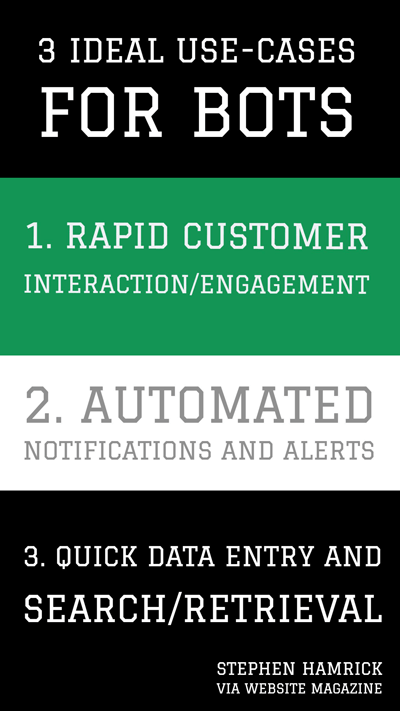Bad Bot, Good Bot. [A Q&A with SAP]

From automating customer service within live chat or messaging apps to generating fake social activity and carrying out malicious attacks on websites, bots - good and bad - are all around us on the Web.
With consumer-facing bots already taking off - like the ability to schedule an appointment in Facebook Messenger or get automated travel assistance - and business-focused bots providing intelligent recommendations (among other capabilities), both B2C and B2B enterprises will start to wonder which of their tasks bots can automate to reduce costs and improve customer experience.
Not so fast warns Stephen Hamrick, vice president of product management at SAP, who believes that bots are hurting productivity more than they are helping it. Hamrick concludes that the bot technology available today is not advanced enough to actually be useful; instead, it sounds exciting but doesn't deliver.
Website Magazine connected with Hamrick to learn about the current pitfalls and potential of bots, particularly as it relates to everyday use-cases and convergence with artificial intelligence (AI). Let's jump in.
What are some ideal use-cases for bots within an enterprise?
Stephen Hamrick, SAP: Broadly, there are at least three major categories where bots can provide a significant advantage over a traditional software experience:
- Rapid customer interaction/engagement: There are many cases where having a chat bot as a front-line support or Q&A answer desk can afford for a much better customer experience overall. We've seen many customers starting with simple chat bots that attempt to use natural language processing and a search index to match a customer's question about a product or service with a known set of knowledge-based articles. Chat bots never get tired, they are available 24/7, and they can always make a connection with a human customer support representative if they're having trouble determining what the customer needs. This makes them an ideal way to reduce support costs while improving customer satisfaction.
 Automated notifications and alerts: It can be difficult to sift through a torrent of emails to find an automated alert from a transactional application (such as a customer relationship management, expense reporting, or human capital management system). For example, a sales rep may want to know exactly when a new lead is generated in the system that they need to follow-up on. Or someone on the digital marketing team may want to be alerted about the performance trend of an ongoing campaign. The parameters of an event about which a person should be notified also need to be adjusted easily and often, preferably without having to navigate back to the transactional system. Chat bots can again be very useful in this context: they can take a set of parameters in plain language and automate an alert back to the employee. The alert will appear on their mobile device, making it easier to pay attention to high priority trends happening within their business. This improves employees' abilities to respond quickly to critical alerts, and improves the return on investment from existing transactional applications.
Automated notifications and alerts: It can be difficult to sift through a torrent of emails to find an automated alert from a transactional application (such as a customer relationship management, expense reporting, or human capital management system). For example, a sales rep may want to know exactly when a new lead is generated in the system that they need to follow-up on. Or someone on the digital marketing team may want to be alerted about the performance trend of an ongoing campaign. The parameters of an event about which a person should be notified also need to be adjusted easily and often, preferably without having to navigate back to the transactional system. Chat bots can again be very useful in this context: they can take a set of parameters in plain language and automate an alert back to the employee. The alert will appear on their mobile device, making it easier to pay attention to high priority trends happening within their business. This improves employees' abilities to respond quickly to critical alerts, and improves the return on investment from existing transactional applications.
- Quick data entry and search/retrieval: Not every screen in a transactional system can be easily replicated into a chat bot environment, but many that require minimal fields to create a record can be automated via a chat bot. Examples would include filing an expense report receipt, uploading an image of a business card, or registering an email address to a mailing list. It's also very convenient and much faster to search and retrieve specific records from a chat bot. An example would be a sales rep asking a chat bot to retrieve the address of the next customer she or he needs to visit. These kinds of chat bots greatly improve the adoption of existing transactional business applications and can improve productivity and effectiveness of line-of-business employees.
Are we "there yet" in terms of the technology available to effectively deliver on those use-cases?
Hamrick, SAP: We are a good portion of the "way there" in terms of these technologies being broadly available. The cost and complexity of some of the underlying components, such as machine learning and natural language processing, have come down significantly over the last few years, making such chat bots much more feasible than they were just a few years ago.
There are, however, still lots of areas for improvement. Natural language processing still has its challenges when it comes to turning complex requests into commands that a chat bot can understand. Chat bots can't understand intent or emotion in a human capacity, so for some customer service chat bots, the tone and emotion of the customer may not be well understood, potentially leading to negative customer experiences. Additionally, there haven't been as many standards developed regarding how chat bots interact between various chat platforms. This means that portability is often very low, so bots end up being re-written for each platform in which they're deployed.

Similarly, what do brands need to think about in terms of bots seamlessly exchanging information with other technology systems in place?
Hamrick, SAP: Brands should think carefully about what kinds of transactions they want bots to handle, especially in a bot-to-bot scenario. This is an area that is still heavily dependent on the bot's mutual understanding of language, and processing natural language can lead to unexpected results. The reason that most developers still rely on very heavy API specifications today is due to the importance of machine-to-machine transactions being reliable and scalable. Chat bots may not be either reliable or scalable, and therefore should be considered only an experiment for non-critical functions until or unless they've proven an ability to handle exceptions, and scale well under heavy load.
There are plenty of "build a bot in 10 minutes" type claims, but what pitfalls do these bots have?
Hamrick, SAP: Most of these bots are extraordinarily limited in their ability to respond with dynamic content. They're not necessarily programmed to come back with a secure integration to a transactional business application, and they typically only know very reflexive answers to a narrow set of questions. It's the human equivalent of teaching a dog to fetch your slippers: a dog can learn to repeat a basic and narrowly defined command easily. If the dog knows exactly what your slippers look like and where you usually keep them, it can repeat that command reliably. But the moment you want to do something more complicated, like ask your dog to fetch your running shoes from the back porch, don't be surprised if you still end up getting your slippers instead. The same is true for these basic bots. They'll do some things you teach them reliably, but anything more complicated will require better and more sophisticated development.
What advice can you offer enterprises that are intrigued by bots but have yet to implement any?
Hamrick, SAP: For companies just exploring bots now: start small, and set reasonable goals. Find something that is not yet so business critical that you can't afford to take the risk that the bot might provide unreliable answers. If your first use case is within customer support and how you engage with your customers, be sure that the bot does not take too long to connect with a human, otherwise the bot may irritate your customers. Test, measure, and test with lots of qualitative and quantitative data. We've seen companies do this successfully by rolling out chat bots for limited purposes both internally and externally, and this seems to be the most effective way to go. The initial return on investment can be used to continue broadening out chat bots to other use cases, rather than attempting to over-promise and deliver on too many use cases at once, and fail to deliver any value.

How can AI technology work to make these bots more beneficial?
Hamrick, SAP: AI will help chat bots in several areas. First, and perhaps most important, is being able to understand intent, and use that to better interpret what the customer is asking, and potentially come up with new solutions that were not previously designed by the chat bot developer. An example would be: imagine a chat bot is helping a customer with a hotel room. The customer has a question about whether the room is a non-smoking room or not. The chat bot could look up the registration based on a previously designed algorithm to respond to an inquiry about a room. If the booking did not specify a non-smoking room, the bot may have been only programmed to respond with the room information. Rather than just let the customer know their room is non-smoking, based on the bot learning from prior transactions, the bot could check to see if non-smoking rooms are available on the dates specified in the reservation and proactively ask if the customer wants to change their room type, letting them know that non-smoking rooms were available on the dates they booked.
Secondly, and equally important, is the ability to learn from customers themselves through repeat solutions being suggested by the customer. For example: a bot may learn that a recurring problem can be more easily solved by skipping ahead in its normal troubleshooting steps.
Anything else you'd like to add?
Hamrick, SAP: Chat bots are certainly one of the hottest areas in technology today. They hold a high amount of potential. As with any other tech fad, most companies have yet to conclude that chat bots are here to stay, and that they have provided lasting value. Companies that are risk averse, or that have clientele that prefer human interaction to rapid responses may want to reconsider diving-in on this cutting-edge technology. However, there are some trends that are longer-term, that aren't just limited to chat bots of today.

Natural language processing and machine learning/artificial intelligence are longer-term trends that will continue well into the future. They have already demonstrated huge value in being able to understand sentiment and intent, and to predict trends, outside of the application of these technologies in chat bots today. These are areas that companies should consider investing in now, especially to begin collecting data to train the software. The larger the body of data that an automated or artificially intelligent piece of software can learn from, the better its predictions and actions will be from the beginning.
+ Stephen Hamrick is the vice president of product management at SAP. Connect with Hamrick on LinkedIn and Twitter.

Subscribe to Our Newsletter!
Latest in Software






![Bad Bot, Good Bot. [A Q&A with SAP]](https://www.websitemagazine.com/hubfs/Imported_Blog_Media/bot-2-1-1-1.jpg)

